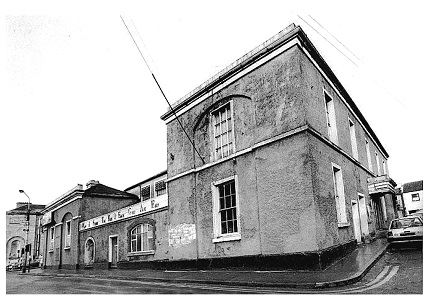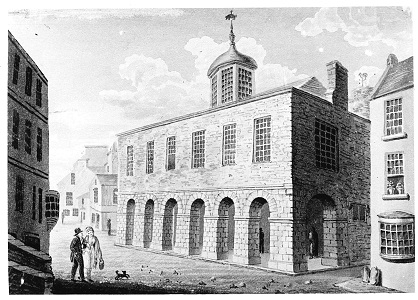THE TOWN HALL, A BRIEF HISTORY

by Tom Kenny
In 1639, the Corporation ordered that some of the shops and buildings adjacent to the market be pulled down and “all the same be reduced into a strong sufficient stone house, covered with slate and to be underpropped with good stone pillars, whereby way through it shall be to the said church”. The proposed building was to be opposite the present Anthony Ryan’s shop and was to be a Tholsel or premises for the town clerk, for the Corporation records and for meetings of the Common Council.
There were many delays in the completion of the building but, in 1709, it was finally open for use. It functioned as an exchange, a market building, a municipal office as well as a courthouse. Little over a century later, it was condemned as dangerous and in 1822, it was demolished. The stones from it were in the possession of Thomas Barnwell Martin of Ross and he used them to build a new market house on Eyre Square which is now the Bank of Ireland building on Eyre Square.
Two hundred years ago tomorrow, on June 21st, 1824, the construction of a new Town Hall began. It was designed by Alexander Hay and erected as the town courthouse, directly opposite the newly built county courthouse. The two separate courthouses represented the distinction between “the county of Galway” local administration and that of “the county of the town of Galway”. Each had its own grand jury. Eventually, it was decided to merge the two courthouses and it was suggested that the building should be passed to the Galway Town Improvement Commissioners. There were many legal difficulties to be overcome but finally, in 1894, the Town Courthouse became the Town Hall. It had functioned as such for many years and continued to do so.
It was run by a Mrs. Murray until the Hardiman family took it over in 1916. It functioned as a dance hall, a centre for meetings and hosted variety shows, concerts, political rallies, fundraisers, boxing matches, etc. We know that it was showing films in 1912 – one of the earliest being “The God of the Sun” in which a thrilling array of elephants, panthers, lions, tigers and snakes play important parts. By the following year, it was showing films nightly, though it continued to host other form of entertainment.

In October, 1911, Christabel Pankhurst addressed a suffragette meeting here. The 1913 Oireachtas was organised here and is commemorated in the very important historic photograph now on display in the foyer. The Galway branch of the Volunteers was set up here in October 1913 when Roger Casement and Eoin McNeill addressed the crowd. During World War !, the British Army set up recruiting meetings here, at least one of which was badly disrupted when the Volunteers cut off the electricity and let off stink bombs which had been made in the Chemistry Department of UCG. The building had to be closed for the following fortnight because of the appalling smell which lingered.
In 1915, the newly formed County Galway War Fund Association held meetings here to decide on the most efficient way to support troops at the front. In February 1916, “The Great Recruiting Conference” was addressed by the Lord Lieutenant of Ireland and John Redmond. Frank Hardiman, who was now managing the building, was arrested and imprisoned in Frongoch after the 1916 Rising. On Armisitice Day, 1918, a “Peace Dance” was quickly organised here.
In December, 1920, the British Army set up an internment camp in the Town Hall where conditions were so bad that two of the prisoners died while in custody. They are now commemorated in a plaque in the building. The Republican Prisoners Fund organised a céilí in October 1921 as a fundraiser. It was packed and a fight broke out outside when some auxiliaries tried to gain access. They shattered the windows with gunfire and the building was surrounded by the Black and Tans who were checking everyone coming out. A Volunteer inside had two revolvers which meant certain death if discovered, so Peg Nicholson, a member of Cumann na mBan carried them out in her knickers.
In 1937, the first meeting of the restored Galway Corporation was held here and elected our first mayor in modern times, Joseph Costelloe. The Town Hall continued mainly as a cinema but also hosted concerts, drama groups, meetings etc. but in spite of occasional renovations, it began to deteriorate and eventually closed down. Then, Michael D. Higgins became Minister for Arts and financed the restoration of the building and it formally reopened in 1996. Since then, under the management of Mike Diskin and latterly, Fergal McGrath, it has made an enormous impact on the cultural life of the city. In the past it hosted groups like the Patrician Musical Society, the Celtic Arts Theatre and visiting groups. In recent times, it has been associated with, among others, Druid, Cúirt, The Arts festival, The Film Fleadh and many others. Long may it continue to do so.
Our images today are of the Tholsel, a drawing that was done for Hardiman’s History c.1820 and the Town Hall Cinema. You can date the photograph if you can remember when the films “Honey, I shrunk the Kids” and “Earth Girls are Easy” were showing there.
.png)